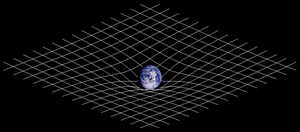Theory of relativity
Theory of relativity

Two-dimensional projection of a three-dimensional analogy of spacetime curvature described in general relativity
The theory of relativity usually encompasses two interrelated theories by Albert Einstein: special relativity and general relativity.[1]Special relativity applies to elementary particles and their interactions, describing all their physical phenomena except gravity. General relativity explains the law of gravitation and its relation to other forces of nature.[2] It applies to the cosmological and astrophysical realm, including astronomy.[3]
The theory transformed theoretical physics and astronomy during the 20th century, superseding a 200-year-old theory of mechanics created primarily by Isaac Newton.[3][4][5] It introduced concepts including spacetime as a unified entity of space and time, relativity of simultaneity, kinematic and gravitational time dilation, and length contraction. In the field of physics, relativity improved the science of elementary particles and their fundamental interactions, along with ushering in the nuclear age. With relativity, cosmology and astrophysics predicted extraordinary astronomical phenomena such as neutron stars, black holes, and gravitational waves.[3][4][5]
Development and acceptance
Albert Einstein published the theory of special relativity in 1905, building on many theoretical results and empirical findings obtained by Albert A. Michelson, Hendrik Lorentz, Henri Poincaré and others. Max Planck, Hermann Minkowski and others did subsequent work.
Einstein developed general relativity between 1907 and 1915, with contributions by many others after 1915. The final form of general relativity was published in 1916.[3]
The term "theory of relativity" was based on the expression "relative theory" (German: Relativtheorie) used in 1906 by Planck, who emphasized how the theory uses the principle of relativity. In the discussion section of the same paper, Alfred Bucherer used for the first time the expression "theory of relativity" (German: Relativitätstheorie).[6][7]
By the 1920s, the physics community understood and accepted special relativity.[8]It rapidly became a significant and necessary tool for theorists and experimentalists in the new fields of atomic physics, nuclear physics, and quantum mechanics.
By comparison, general relativity did not appear to be as useful, beyond making minor corrections to predictions of Newtonian gravitation theory.[3] It seemed to offer little potential for experimental test, as most of its assertions were on an astronomical scale. Its mathematics seemed difficult and fully understandable only by a small number of people. Around 1960, general relativity became central to physics and astronomy. New mathematical techniques to apply to general relativity streamlined calculations and made its concepts more easily visualized. As astronomical phenomena were discovered, such as quasars (1963), the 3-kelvin microwave background radiation (1965), pulsars (1967), and the first black hole candidates (1981),[3] the theory explained their attributes, and measurement of them further confirmed the theory.

Comments
Post a Comment